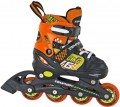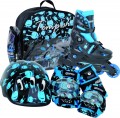Kit
The kit determines the complete set of roller skates — in addition to the rollers themselves, it may include various accessories, primarily protective gear.
—
Protective gear. In this case, the only protection for the limbs is meant: knee pads, elbow pads, and gloves (the specific set may be different). This option can be useful if you already have a helmet or want to select it separately. At the same time, such equipment is relatively rare — many manufacturers see no reason to supply protective gear without a helmet.
—
Protective gear and helmet. Kits that include both certain limb protection devices (see above) and a helmet to protect the head. A helmet is one of the most important pieces of equipment for roller skates: if a fall on an unprotected arm or leg is most often fraught with abrasions and scratches, then the consequences of head injuries can be much more serious. Therefore, in most kits, supplemented with protective equipment, a helmet is provided.
Note that protection will be useful for any skater, but it is especially relevant for two categories — beginners who acquire basic riding skills, and professionals who deal with complex movements and high speeds. At the same time, the "roller skates+equipment" kits, usually, belong to the primary category and are designed for children. It is because professional equipment is easier to purchase separately, choosing spe
...cific items for your preferences and needs, rather than relying on the manufacturer's decision. But for a beginner, on the contrary, it is easier to immediately acquire everything necessary for a safe ride.Wheel size
The diameter of the wheels supplied with roller skates.
This parameter is usually selected by the manufacturer based on the style of riding for which the rollers are designed (see above). The general rule is this: the
larger the diameter, the more “high-speed” the wheels are considered and the less sensitive they are when hitting bumps. Wheels with a diameter of about 76 – 82 mm are considered universal, these are the sizes that are found in most fitness roller skates and stunt models (see "Riding style"). In running equipment, this size can be noticeably larger — this is done to ensure a fast and smooth ride. But on the "aggressive" models, the wheels, on the contrary, are small — with this driving style, it is critical to feel all the bumps under the rollers.
Bearing
Class of bearings installed in roller skates.
There are several standards by which this parameter can be designated. The most popular is ABEC (Annular Bearing Engineering Committee), and the ILQ (InLine Qualified) designation is also common. In both cases, the bearing class is expressed by a number after the abbreviation:
ABEC 1,
ABEC 3,
ABEC 5,
ABEC 7,
ABEC 9 or
ILQ 5,
ILQ 7,
ILQ 9. The higher this figure, the higher the accuracy with which the bearing is made, and the higher the quality (and, accordingly, the more expensive it is). The meaning of specific numbers in both standards is the same. So, class 1 and 3 bearings are typical mainly for entry-level children models, and they are used not so much to reduce cost, but because it simply does not make sense to install better parts in such rollers. Class 5 is considered quite sufficient for mid-level fitness roller skates and inexpensive stunt models (see "Riding style"), and higher values are typical mainly for professional equipment.
We note that the class of bearings is not related to their speed characteristics — it is only about the overall build quality. But this parameter noticeably affects the service life: precise fitting of
...parts helps to reduce their wear and increase the durability of bearings.Boot type
The type of boot provided in the design of roller skates.
—
Soft. Such boots are similar in design to high sports shoes made of soft materials, reinforced where necessary with hard materials (most often plastic). Such shoes comfortably and tightly sit on the foot, provide good ventilation, and are light in weight. Of its practical shortcomings, one can only note a slightly lower strength than that of hard boots. However, it can become noticeable only in difficult driving modes, with an abundance of loads (primarily side loads). In addition, the soft part of the boot is not always removable, which can complicate its cleaning. In light of all this, soft boots are very popular in all types and price categories of modern roller skates — except that in "
aggressive " models (see "Riding style") they usually have a soft part only on top and at first glance do not differ much from hard ones.
—
Hard. Boots are made entirely of solid materials and equipped with a soft insert for comfortable placement of the foot inside. Historically, this is the first type of roller skate boot, but today it is much less common than the soft variety. This is due to several inconveniences: hard boots are less ventilated, weigh more, and also require increased attention to the choice — the slightest mismatch in the shape of the foot can cause serious discomfort. However, they have
...high strength and resistance to lateral loads. Therefore, hard boots are still used in some models of inline skates — both for fitness and for stunt riding (see "Riding style").Boot material
The main material used in the design of the boot. Note that this material is not the only one: soft varieties of shoes (see “Shoe type”) are necessarily complemented by a rigid frame; hard ones, on the contrary, with a soft insert. However, the features of the boot depend primarily on the base material.
— Nylon. The soft material used in roller skates with the appropriate type of boot. This material is very popular in sports shoes in general and roller skates in particular: it is inexpensive, durable enough, and can be of any colour, and there are many varieties of nylon on the market, including those with rather advanced features. Thanks to all this, nylon is today, in fact, the main material for soft boots of all levels, from the simplest to the professional.
— Faux leather. Material that imitates the appearance of genuine leather. Like nylon, it is used for soft boots and has many varieties that vary in quality. However, for several reasons, the use of faux leather is typical mainly for fairly advanced skates, including
running models, and the quality of this material is quite consistent with the class of equipment.
— Microfibre. Another option is found in soft varieties of boots. Microfibre is based on polymer synthetic threads of extremely small thickness, due to which this material has several useful features. In particular, it retains heat well and at the same time provides moisture removal, allowing
...the skin to "breathe", while it dries quickly, and is easy to clean and wash. At the same time, microfibre is not cheap. As a result of all this, it is a professional sports material and is found in models of the appropriate level (and even then quite rarely).
— Plastic. This material is the same material for hard roller skate boots as nylon is for soft ones. It is characterized by a combination of low cost with an abundance of colours and good durability characteristics. It is also available in many grades, among which you can choose an option for almost any occasion — from inexpensive children's skates to durable professional models. And the fact that plastic shoes are rare is not due to the characteristics of plastic, but to the low prevalence of hard shoes in general.
— Carbon fibre. Material based on elongated carbon fibre filaments. It is used in hard boots and is considered very advanced: at a lower weight than plastic, carbon fibre has an extremely high strength, comparable to the characteristics of steel. At the same time, in roller skates, even professional ones, such strength is rarely required, and boots made of this material are not cheap. Therefore, carbon fibre is not widely used.Foot fixation
The method of fixing the foot, provided in the design of roller skates.
—
Buckle. The buckle of a special design is one of the components of such a latch. A strap (most often rubber or plastic) with special notches is threaded into this buckle; while the buckle is unfastened, the strap can move freely, and when fastened, it is fixed, holding the foot as well. At the same time, the combination of the special design of the clasp with the mentioned notches on the strap provides a secure hold, and the buckle is unfastened quite easily.
—
Hook-and-loop. Strap-style fastener held in place with a classic hook-and-loop fastener. The action of hook-and-loop is based on the use of small hooks on one half of the fastener, which cling to the felt backing on the second half. Such fasteners are extremely easy to use: the halves “stick” to each other without much effort on the part of the user (hence the name), and to unfasten it is enough to pull the edge of the strap up, gradually disengaging the halves. Thanks to this, hook-and-loop can be used without problems even by kids. On the other hand, such fasteners are considered less reliable than buckles and are practically not used on their own.
— Lacing. Classic lacing, similar to that used in regular shoes. Note that this type of fixation can be used in both soft and hard boots (see "Boot type") — in the latter case, the laces tighten th
...e halves of the boot in the upper part, pressing it to the instep of the foot. Regardless of the type of boot, this fixation is very effective, as it covers a large area and provides a good contact density. Of its shortcomings, one can note poor suitability for kids, who may have difficulty with a strong tightening of the laces.
Note that rollers with one type of fixation are quite rare — usually, certain combinations are used.Heel strap type
Type of heel strap provided in the design of roller skates; more precisely, the type of fastener provided on such a belt.
The heel strap covers the leg at the level of the ankle joint. Such a strap is usually located at an angle of approximately 45° to the horizontal; its purpose is to press the user's heel, providing the necessary density of contact between the sole and the foot. The main types of fasteners used for heel straps are buckle and hook-and-loop; their features are described in detail above, in the paragraph “Foot fixation” (in fact, this strap also belongs to the system of such fixation).

